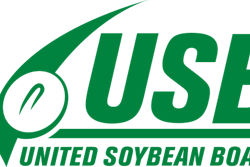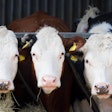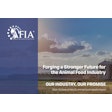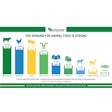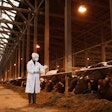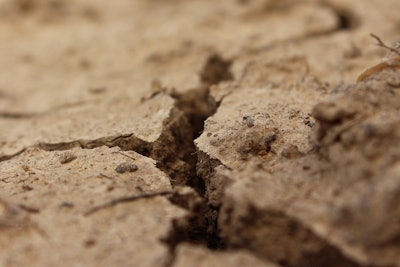
4. Increased market volatility
The past few years have already taught producers about the vulnerability of supply chains, Hatfield says. But weather and even disease aren’t the only potential risks of climate change. Political unrest and even war could become more common in a warmer, more volatile future. Strict regulations could trigger sudden changes in what may be sold and how. Even innovation and demand for green energy and biofuels could cause major disruptions to global markets.

“Lack of food and water does cause a lot of conflict around the world,” Hatfield says. “There are a lot of geopolitical influences that cause conflicts within countries and unrest. But it comes back to — if people are hungry and thirsty, they have a real desire for survival, so they’re going to take some pretty drastic approaches to make sure they’re still here tomorrow.”
For most feed mills, Hatfield says, taking this increased variability into account is a critical first step toward a climate mitigation strategy. Producers should take stock of where their feed comes from and the kinds of disruptions that could occur — and then think through a strategy for how they will address those disruptions if they become more frequent.
“Really think about, do I, in the good years, fill up more of my bins so if next year is lean I still have the capacity to supply my needs,” Hatfield says. “Do a lot of proactive thinking about your production area and resource area, in terms of your supply.”
Other potential strategies, in addition to increased storage, could include working with a more diverse range of suppliers, or even buying up less common, more climate-resilient feed ingredients like sorghum in order to promote the development of a new market, Hatfield says.
“The magic word in all of this is we need to be much more proactive in our thinking about where we are today, and about where we will be 10 to 15 years from now,” he says. “We as humans are not very good at long-range planning. We tend to be much more reactionary than we are proactive, and I think a lot of this is just … how do we look at our production systems, how do we build resilience, how do we build the capacity we need to meet all the sectors that are out there.”
But the good news, Hatfield says, is there’s ample reason to believe if we plan for change in advance, we will be able to adapt to whatever changes of weather and climate the future holds in store.
“I actually do believe we could create a system that short of a massive drought — if it doesn’t rain all summer all bets are off — we can stabilize production,” Hatfield says. “We’ll see some wiggles in there, but we won’t see widespread impacts.”
Weather has always represented one of agriculture’s greatest challenges.
“As one producer told me one time,” recalls Jerry Hatfield, “he says, you know, if I knew what the weather was going to be, I’d know how to farm. And I told him that if I knew what the weather was going to be, he couldn’t afford to talk to me.”
Hatfield, a former laboratory director and plant physiologist for the U. S. Department of Agriculture’s (USDA) Agricultural Research Service (ARS), is one of the world’s leading experts on the impact of climate and extreme weather on ecosystems, crops and livestock production.
In 2007, his work on climate change made him a joint recipient of the Nobel Peace Prize. And these days, producers can’t afford to not talk to him — industry and academics leaders keep him busy with their questions about the weather of the future, in spite of the fact that he’s technically retired.
As any farmer knows, trying to forecast the weather is always a fickle endeavor. But there are some things, Hatfield and other experts agree, that are becoming increasingly clear. As the climate continues to warm in response to increased greenhouse gases in the Earth’s atmosphere, where and how we produce crops will need to change with it, Hatfield says.
The nutritional needs of livestock will change as they adapt to warmer nights and less relief from the hot daytime sun.
And the more things change, the more they’re going to stay the same — at least with respect to predicting the weather. Because as the climate warms, Hatfield says, the weather will become less predictable, requiring feed producers to prepare for ongoing, long-term volatility in commodity markets.
“Let’s not be so pessimistic in this whole thing that we say, well, there is nothing we can do, so let’s not do anything,” Hatfield says. “We need to be much more proactive in the way we think about this problem, and adaptation strategies that allow us to reduce the impact of climate and weather variability.”
Feed & Grain Editor's Poll
1. More soybeans, less corn
When it comes to crop production, experts agree, the impacts of climate change can be sorted into two broad categories. Increased temperatures will influence the kinds of crops we produce, and they will shift the production of those crops to more northern latitudes.
.jpg?auto=format%2Ccompress&fit=max&q=70&w=400)
In an ideal season, the weather would deliver rain when it’s needed, and warm but not excessively hot growing conditions, says Monica Jean, an extension field crops educator for Michigan State University. While this is never guaranteed, it’s even less likely in a future where carbon emissions continue to increase and average temperatures continue to rise.
A warming atmosphere, Jean explains, not only increases the chances a given region will experience extreme heat and drought. Warm air also has a greater capacity to hold water, and that means extreme precipitation and flooding will also become more common. The frequency of heavy precipitation has already climbed 27% to 37% in the eastern U.S. — and jumped 71% in the Northeast.
This variability could be especially damaging to corn production, because of corn’s sensitivity to inclement weather during the pollination period, according to Heather Karsten, an associate professor of crop production ecology at The Pennsylvania State University. Soybeans, on the other hand, may be more resilient.
“Soybean seems to be one where there is more opportunity, because it can produce a crop as an indeterminate crop,” Karsten says. “It can keep flowering — it doesn’t only have an ear like a corn plant that would be termi- nated and unable to produce grain. Models indicate that corn will be more limited, with more yield reduction in the significant climate change scenarios in the future, than perhaps soybeans or other crops.”
This doesn’t mean soybeans are invulnerable to climate change, Hatfield says. But they are a bit more resilient in terms of their ability to tolerate bad weather.
“In corn we’ve got stresses throughout the year. If we get stressed really early, we reduce the potential ear size, so we’ve already limited yield at that point. If we get really high temperatures, dry conditions during pollination, we can reduce grain set. And then if we get stresses during the grain filling period, we reduce kernel size, so that reduces yield,” Hatfield says. “Soybeans have more flexibility, but we do see impacts. Stress early in the season will see reduced pods per node, and stress later will reduce the number of seeds per pod. We see the same thing in wheat … ultimately all crops are very sensitive to the changes in climate that are going on.”
2. Moving the Corn Belt north

Climate change is also projected to extend the growing season in most regions of the U.S., with northern states gaining as many as 10 frost- free days per year, according to Jean. This doesn’t necessarily mean all those frost- free days will be conducive to crop production, or that adequate water or soil resources will be available to capitalize on them — but it could have some benefits for northern climes, which have already seen increased crop production and may be able to introduce double-cropping, Karsten says.
This isn’t just a far-distant future scenario, Hatfield says. “If you look at it, we’ve already moved the corn-soybean belt into North Dakota and South Dakota — the eastern third of both those states are as intense now as any place in the Corn Belt,” he says. “So we’ve already moved.”
In the southern third of the U.S, however, a warming climate could push temperatures so high that they actually reduce the length of the growing season, Hatfield says. Farmers in this region may be able to adapt by changing their cropping rotations and planting something like sorghum, which is more heat and drought tolerant, instead of corn. This, in turn, may alter feed formulations in these warmer climates.
The northward shift could also put supply chains at risk if it divorces crop production from the location of the feed mills themselves, Hatfield says. So manufacturers will need to think proactively about the siting of new facilities if they want to avoid high shipping costs and other constraints in the future.
3. Livestock heat stress
When we talk about climate change, the focus is generally on the most visibly dramatic results —scorching heat waves, punishing floods and wildfires. But climate change won’t just affect peak temperatures, Hatfield explains.

It’s also going to raise nightly minimum temperature. And that may have even greater impacts on livestock than the temperature extremes that make headlines.
“Our bodies need to cool down in order to have metabolic rest,” Hatfield says. “So if we’re really warm at night, we’re pretty un- comfortable.”
Increased nighttime temperatures, Hatfield continues, have been associated with increased mortality in feed lots and hog and poultry barns. Dairy and egg production goes down, as does daily weight gain, and livestock overall experience greater infertility as a result of being unable to escape stress and rest at night. And of most concern to feed producers — heat stress will cause almost all animals to exhibit reduced feed intake.
The first line of defense, according to Victor Malacco, dairy extension educator for Michigan State University, is to increase controls in the animals’ environment — offering more shade, even introducing fans or misters for cooling. But these adaptations can only go so far, so diets will also have to change.
In general, this means formulating diets for more energy with reduced feed intake, Malacco says. But considering the source of that energy is also important, he says, because extended periods of heat stress changes the metabolism. Cows, for example, are metabolically inflexible during heat stress, with reduced ability to mobilize adipose tissues, so energy sources that will result in increased glucose precursors may be beneficial.
“We need to work on how we’re going to provide this amount of energy with less dry matter,” Malacco says. “It’s easy to increase the density of the diet, but it’s tricky because to increase the density we usually use more grain, and cows are prone to acidosis, so you can’t increase the grain. The reduction in dry matter intake also happens with swine and poultry, and changes in diet’s nutritional density might be required.”


